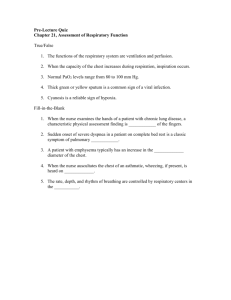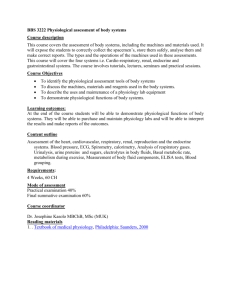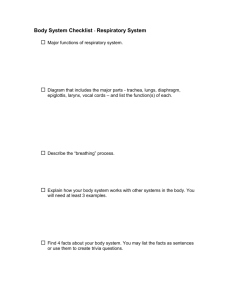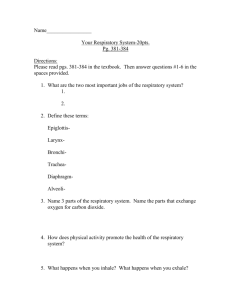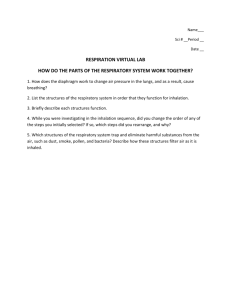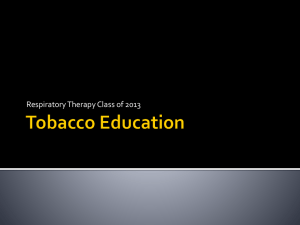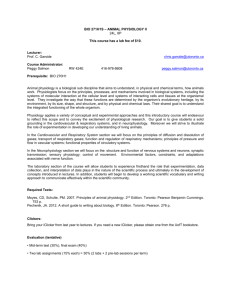Resp Lecture 5 - Gas Transport
advertisement
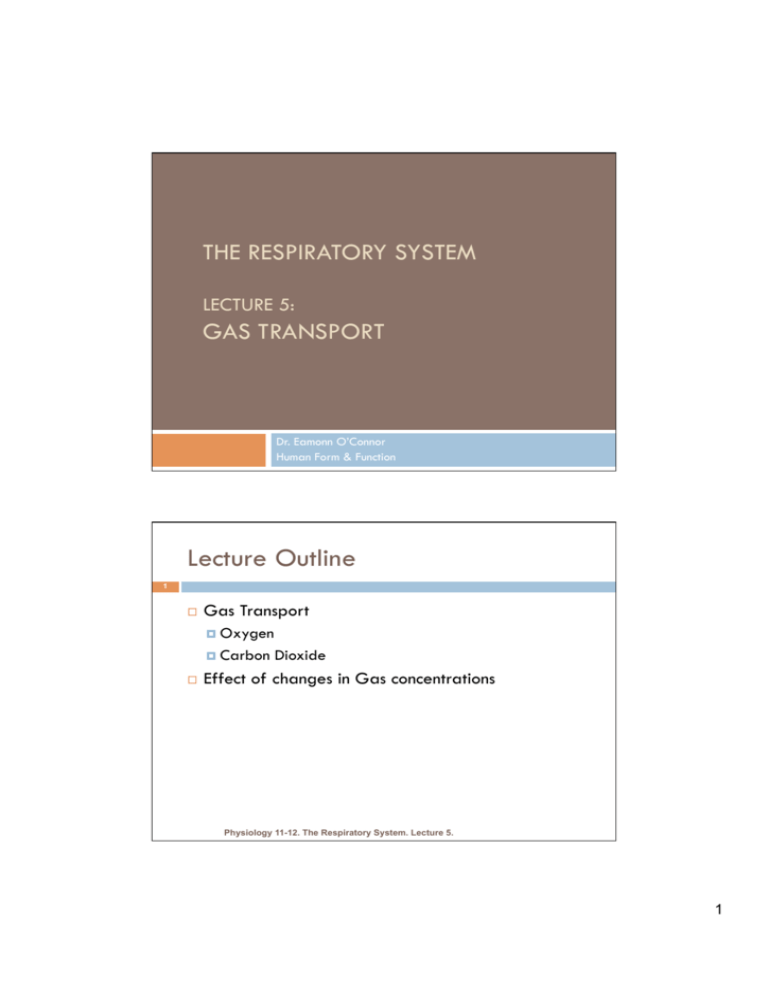
THE RESPIRATORY SYSTEM LECTURE 5: GAS TRANSPORT Dr. Eamonn O’Connor Human Form & Function Lecture Outline 1 Gas Transport Oxygen Carbon Dioxide Effect of changes in Gas concentrations Physiology 11-12. The Respiratory System. Lecture 5. 1 Oxygen Transport 2 2 Forms: 1.5 % Dissolved in plasma a PaO2 = 100 mmHg; 3 ml.litre-1blood (0.3 ml.dl-1) Resting VO2 = 250 ml.min-1 Pulmonary blood flow (CO) = 5L.min-1 (O2 content = 21%) Therefore, O2 breathed = 1L.min-1 15 ml.min-1 of O2 breathed dissolves NB: Only dissolved gas contributes to circulating partial pressures At 98.5 % Bound to haemoglobin binds 1.34 ml O2.g-1 (x130 – 150 g.litre-1) Provides 175 – 200 ml O2.litre-1 (17.5 – 20 ml O2.dl-1) Hb Physiology 11-12. The Respiratory System. Lecture 5. Haemoglobin (Hb) 3 Found only in red blood corpuscles (RBC’s) Structure 150 g.L-1 in men (15 g.dl-1) 130 g.L-1 in women (13 g.dl-1) Tetrameric globular protein 4 Haeme groups (each contain 1 Fe2+ ion) Cooperative reversible binding of up to: 4 O2 molecules 4 CO2 molecules (normally 2 at most in venous blood) Hb always remains partly oxygenated (>40% saturated) Transports 98.5% of O2 in blood Function to provide: Greater oxygen carrying capacity Improved efficiency by ↓ energy expenditure for VE Physiology 11-12. The Respiratory System. Lecture 5. 2 Hb-Oxygen Dissociation Curve 4 Physiology 11-12. The Respiratory System. Lecture 5. Hb-O2 Dissociation Curve 5 Physiology 11-12. The Respiratory System. Lecture 5. 3 Changes in Affinity of Hb for O2 Describes changing affinity of Hb for O2 Right shifted Tissue level unloading Left shifted Lung level loading ↑ PCO2, ↓ pH (↑ H+), ↑ Temperature ↓ PCO2,↑ pH (↓ H+),↓ Temperature 2,3-diphosphoglycerate 2,3-DPG → right shift Metabolite of RBC glycolysis Significant in hypoxia (altitude) Physiology 11-12. The Respiratory System. Lecture 5. Carbon Dioxide Transport 7 Resting VCO2 = 200 ml.min-1 3 Forms Dissolved 10% Bound to Hb 30% Bicarbonate Mostly (HCO3-) in plasma 60% Physiology 11-12. The Respiratory System. Lecture 5. 4 O2 & CO2 Transport 8 Physiology 11-12. The Respiratory System. Lecture 5. Hb-CO2 Dissociation Curve 9 Physiology 11-12. The Respiratory System. Lecture 5. 5 Hypoxia (Insufficient Cellular O2) 10 Hypoxic hypoxia Low PaO2 → ↓ %Hb Sat Inadequate gas exchange ↓ PB (altitude) Cyanosis (skin bluish tint) = 70% Hb Sat Anaemic hypoxia ↓ total blood O2 content with normal PaO2 ↓ circulating RBC’s ↓ RBC Hb content CO poisoning (no cyanosis – HbCO is pink) Circulatory hypoxia ↓ supply of oxygenated blood with normal O2 content and PaO2 Vessel blockage Congestive heart failure Physiology 11-12. The Respiratory System. Lecture 5. Abnormal PaCO2 11 Hypercapnia Excess PaCO2 via hypoventilation (under breathing) Occurs with most lung diseases Occurs in conjunction with reduced PaO2 Hypocapnia Below normal PaCO2 via hyperventilation (over breathing) Occurs with anxiety & fear No impact on PaO2 Except at low PB (e.g. altitude) where low PaO2 stimulates a hyperventilation NB: hyperpnea increased breathing/ventilation to match metabolic demand (e.g. exercise) Physiology 11-12. The Respiratory System. Lecture 5. 6
